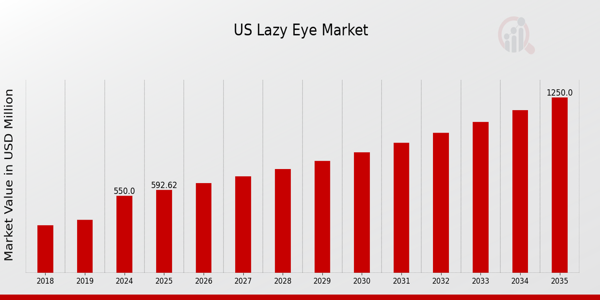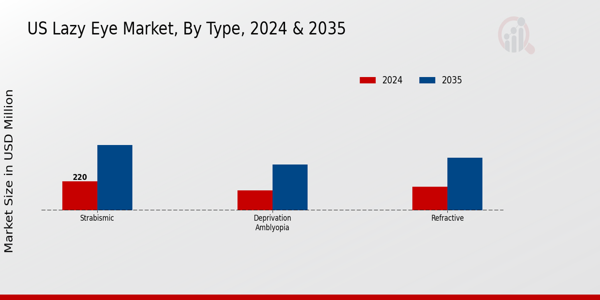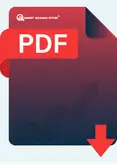US Lazy Eye Market Overview
As per MRFR analysis, the US Lazy Eye Market Size was estimated at 505.52 (USD Million) in 2023. The US Lazy Eye Market Industry is expected to grow from 550(USD Million) in 2024 to 1,250 (USD Million) by 2035. The US Lazy Eye Market CAGR (growth rate) is expected to be around 7.749% during the forecast period (2025 - 2035).
Key US Lazy Eye Market Trends Highlighted
The US Lazy Eye Market is witnessing several key trends driven by advancements in technology and an increasing awareness of vision-related issues among the population. One of the primary market drivers is the rise in early diagnosis and treatment options for amblyopia, which is crucial since timely intervention can significantly improve patient outcomes. The integration of advanced therapies, including digital solutions and interactive games that engage children in treatment, is becoming popular. Additionally, wearable technology like smart glasses designed to treat lazy eye is capturing interest, further propelling the market.
Opportunities are plentiful as more healthcare providers are recognizing the importance of addressing pediatric eye health.
With the growing awareness and emphasis on comprehensive eye exams in children, especially following recommendations from organizations like the American Academy of Pediatrics, there is a significant scope for innovative treatment solutions. Furthermore, educational campaigns aimed at parents regarding the importance of early detection of amblyopia can enhance market growth. Recent trends indicate a shift towards personalized treatment plans tailored to individual patient needs, leveraging data from vision screenings.
The emergence of telehealth services has also gained traction in the US, providing patients with easier access to specialists without the constraints of physical visits.The increasing adoption of home-based therapies has been instrumental in making treatments for lazy eye more convenient for families. Overall, these dynamics are collectively reshaping the landscape of the Lazy Eye Market in the US, highlighting a transition towards more effective and accessible treatment solutions for amblyopia.
Market in the US, highlighting a transition towards more effective and accessible treatment solutions for amblyopia.

Source: Primary Research, Secondary Research, Market Research Future Database and Analyst Review
US Lazy Eye Market Drivers
Rising Awareness and Education Programs
In the United States, there has been a significant rise in awareness and educational programs focusing on eye health, particularly lazy eye, also known as amblyopia. The American Optometric Association has emphasized the importance of early detection and treatment of lazy eye, stating that up to 3% of children are affected by this condition.
Programs aimed at educating parents and caregivers on the risks associated with lazy eye have been seen to increase screening rates among children, which is instrumental for early intervention.According to a survey conducted by the Centers for Disease Control and Prevention (CDC), the number of children receiving vision screening increased by 15% over the past five years. This surge in awareness is likely to drive growth in the US Lazy Eye Market Industry as more children are being diagnosed and treated effectively, acknowledging the critical role that timely education plays in improving child eye health outcomes.
Advancements in Treatment Technologies
The US Lazy Eye Market Industry is experiencing growth due to advancements in treatment technologies such as innovative vision therapy solutions and enhanced surgical procedures. Over the past decade, developments like the use of virtual reality technology for vision therapy have shown promising results in treating amblyopia.
A study published by the National Institutes of Health indicated that innovative treatments, including the use of special video games, have improved visual outcomes in children, with improvement rates reported at 30 to 70% in participants.These advancements have been supported by significant investment in Research and Development by leading organizations like the Vision Council, which aims to improve and standardize treatment protocols for lazy eye.
Increase in Health Insurance Coverage
The expansion of health insurance coverage in the US has positively impacted the US Lazy Eye Market Industry, making treatment for lazy eye more accessible to a broader segment of the population. Data from the Kaiser Family Foundation shows that the number of Americans with private health insurance increased by nearly 9 million between 2010 and 2020, during which coverage for eye care has often been included.
This coverage typically allows for early intervention services, which are critical in the management of amblyopia.The correlation between increased insurance coverage and access to eye examinations implies that more individuals are likely to partake in screenings, leading to earlier diagnoses and, consequently, adoption of treatment protocols.
US Lazy Eye Market Segment Insights
Lazy Eye Market Type Insights
The US Lazy Eye Market is characterized by its segmentation into various types, which includes Strabismic, Refractive, and Deprivation Amblyopia. Each of these types plays a crucial role in the overall market dynamics. Strabismic Amblyopia, often associated with misalignment of the eyes, is noteworthy for its prevalence in childhood, making timely diagnosis and treatment essential for effective management. This type significantly impacts visual development in children, which can lead to persistent vision issues if not addressed.
On the other hand, Refractive Amblyopia arises from uncorrected vision problems such as myopia, hyperopia, or astigmatism, leading to one eye being stronger than the other.This highlights the importance of vision screening in early childhood, as the correct prescription of glasses or contact lenses can greatly enhance visual outcomes.
Lastly, Deprivation Amblyopia is primarily caused by obstructions in the line of sight due to cataracts or other eye conditions, and its treatment often requires surgical intervention. Each type presents unique challenges and requires tailored therapeutic approaches, contributing to the complexity of the US Lazy Eye Market. Understanding these segments enhances insights into market trends, growth drivers, and potential challenges as awareness regarding childhood vision problems increases.Factors such as advancements in treatment options, increasing prevalence of visual disorders, and the rising focus on preventative care are all fueling the market growth in this sector.
Healthcare policies and initiatives aimed at improving children's vision health are likely to play a significant role, offering opportunities for innovation and development within the US Lazy Eye Market.

Source: Primary Research, Secondary Research, Market Research Future Database and Analyst Review
Lazy Eye Market Diagnosis Insights
The Diagnosis segment of the US Lazy Eye Market plays a crucial role in the identification and management of amblyopia, commonly known as lazy eye. Given that early detection significantly improves treatment outcomes, various testing methods such as General Eye Test and Squint Test are utilized to facilitate accurate diagnoses. The General Eye Test serves as an initial screening tool, enabling healthcare professionals to assess overall visual acuity and detect any anomalies.
Moreover, the Squint Test is vital for evaluating strabismus, a condition that may lead to lazy eye if left untreated.With a growing awareness among parents about the importance of eye health, these testing methods are gaining traction. This opportunity is pivotal, especially considering the prevalence of amblyopia among children in the US, making the effectiveness and accessibility of diagnosis even more significant. Thus, the Diagnosis segment not only encompasses various testing methods but also serves as a foundation for intervention strategies, emphasizing its importance in the broader context of the US Lazy Eye Market dynamics.
Lazy Eye Market Treatment Insights
The Treatment segment of the US Lazy Eye Market is essential in addressing this common visual disorder, characterized by the failure of one eye to achieve normal visual acuity. Among the various methods of treatment, corrective eyewear plays a significant role as it not only aids in improving vision but also helps in the alignment of the eyes. Eye patches are prominently utilized, particularly in children, to occlude the stronger eye and encourage the weaker eye to develop better vision, demonstrating their importance in early intervention.
Atropine drops are also noteworthy; they are an effective pharmacological method used to blur the vision of the stronger eye, thereby stimulating the weaker eye.The diversity in treatment methods reflects the growing understanding of lazy eye's complexity and the need for personalized treatment approaches. Additionally, the rising awareness of vision health and increasing healthcare accessibility in the US contribute to the growing utilization of these treatments, reinforcing the importance of ongoing education and support for patients and families dealing with lazy eye.
The overall drive towards early detection and intervention continues to present opportunities for growth within this segment, ensuring that individuals receive timely and effective treatment.
Lazy Eye Market End User Insights
The End User segment of the US Lazy Eye Market plays a crucial role in facilitating access to treatment and management options for patients. Retail pharmacies serve as a significant channel through which patients can acquire remedies, including eye patches and corrective lenses, to address amblyopia. They are strategically positioned in communities, making it convenient for individuals to access these critical products without delay.
The growing prevalence of lazy eye, coupled with heightened awareness regarding eye health, has led to increased demand for retail pharmacy services.Retail pharmacies not only provide the necessary products but also offer professional guidance and recommendations, enhancing patient compliance and care outcomes. As a result, they are seen as essential partners in the management of lazy eye, contributing to a broader understanding of the condition among patients and caregivers. With the increasing focus on preventive health measures and consultations in pharmacies, retail pharmacies are expected to maintain a significant influence in the landscape of the US Lazy Eye Market.
US Lazy Eye Market Key Players and Competitive Insights
The competitive landscape of the US Lazy Eye Market is characterized by a dynamic interplay of innovative therapies, strategic partnerships, and an evolving understanding of the condition. As healthcare providers and researchers continue to delve into the complexities of amblyopia, there is a growing emphasis on developing effective treatment options that cater to diverse patient demographics. The market consists of established pharmaceutical companies as well as newcomers, each contributing to a portfolio of therapies aimed at addressing the needs of those suffering from Lazy Eye.
The competition is driven by factors such as product efficacy, research and development capabilities, regulatory approvals, and the ability to navigate the intricacies of market entry strategies successfully.
Genentech holds a significant position within the US Lazy Eye Market, bolstered by its extensive research initiatives and commitment to uncovering innovative solutions for vision-related ailments. The company is known for its robust pipeline focusing on various ophthalmic disorders, with a particular emphasis on those related to visual acuity and eye health. Genentech’s strengths lie in its strong brand reputation, scientific prowess, and collaborative efforts with healthcare professionals, ensuring that it remains at the forefront of advancements in treatment modalities for Lazy Eye.
The company's established relationships with healthcare providers and a focus on patient-centered approaches further enhance its competitive stance in this specific market.
Santen Pharmaceutical also plays a vital role in the US Lazy Eye Market, recognized for its dedicated advancements in ophthalmic treatments. Santen's key products range from innovative therapeutic solutions to traditional methods aimed at promoting better eye health and vision, specifically tackling challenges associated with Lazy Eye. The company boasts a strategic market presence paired with a strong research and development ethos that drives the ongoing evolution of their product offerings. Santen Pharmaceutical has also engaged in strategic mergers and acquisitions, enabling it to enhance its portfolio and expand its reach within the US market.
The strengths of Santen lie in its specialized knowledge of ophthalmology, evidenced by a continuous commitment to new product development that meets the unique demands of Lazy Eye patients while remaining agile enough to adapt to emerging trends in this sector.
Key Companies in the US Lazy Eye Market Include
- Regeneron Pharmaceuticals
US Lazy Eye Market Industry Developments
Recent developments in the US Lazy Eye Market have been marked by significant advancements and strategic movements among major companies. Genentech and Novartis have shown interest in expanding their product pipelines for amblyopia treatment, while Santen Pharmaceutical has made strides in developing innovative therapies. The market is heavily influenced by collaborations and acquisitions; for instance, in September 2023, Bausch Health announced its acquisition of a smaller company specializing in digital eye care solutions, enhancing its offerings for lazy eye treatment. Additionally, Hoya Vision has reported growth due to increased demand for specialized lenses, which cater to patients with amblyopia.
The US market has seen a notable increase in venture capital investments in startups focusing on ophthalmic technologies. Companies like Alcon and Johnson and Johnson are also increasing their Research and Development efforts to capture higher market shares. The expansion in telehealth services in recent years has created new opportunities for treatment delivery, supporting a growing patient base seeking treatment for lazy eye. The integration of advanced technology and increasing awareness about early diagnosis and treatment options are projected to influence the market trajectory favorably in the coming years.
US Lazy Eye Market Segmentation Insights
Lazy Eye Market Type Outlook
Lazy Eye Market Diagnosis Outlook
Lazy Eye Market Treatment Outlook
Lazy Eye Market End User Outlook
| Report Attribute/Metric Source: |
Details |
| MARKET SIZE 2018 |
505.52(USD Million) |
| MARKET SIZE 2024 |
550.0(USD Million) |
| MARKET SIZE 2035 |
1250.0(USD Million) |
| COMPOUND ANNUAL GROWTH RATE (CAGR) |
7.749% (2025 - 2035) |
| REPORT COVERAGE |
Revenue Forecast, Competitive Landscape, Growth Factors, and Trends |
| BASE YEAR |
2024 |
| MARKET FORECAST PERIOD |
2025 - 2035 |
| HISTORICAL DATA |
2019 - 2024 |
| MARKET FORECAST UNITS |
USD Million |
| KEY COMPANIES PROFILED |
Genentech, Santen Pharmaceutical, Vision Source, Valeant Pharmaceuticals, Hoya Vision, Bausch Health, Iridex, Novartis, AstraZeneca, Carl Zeiss, Regeneron Pharmaceuticals, Rayner, Alcon, AbbVie, Johnson and Johnson |
| SEGMENTS COVERED |
Type, Diagnosis, Treatment, End User |
| KEY MARKET OPPORTUNITIES |
Increasing telehealth services, Advanced therapeutic devices, Growing pediatric awareness campaigns, Rising incidence of visual disorders, Enhanced digital health interventions |
| KEY MARKET DYNAMICS |
increasing prevalence of conditions, growing awareness and diagnosis, advancements in treatment options, government support and funding, rising healthcare expenditure |
| COUNTRIES COVERED |
US |
Frequently Asked Questions (FAQ):
The US Lazy Eye Market is expected to be valued at 550.0 million USD in 2024.
By 2035, the US Lazy Eye Market is projected to reach a value of 1250.0 million USD.
The expected CAGR for the US Lazy Eye Market from 2025 to 2035 is 7.749%.
The Strabismic segment is anticipated to have the largest market share, projected at 220.0 million USD in 2024.
The Refractive segment is expected to reach a market size of 400.0 million USD by 2035.
Major players include Genentech, Santen Pharmaceutical, Vision Source, and Valeant Pharmaceuticals.
The market size for Deprivation Amblyopia is projected to reach 350.0 million USD by 2035.
The growth opportunities stem from advancements in treatment methods and increasing awareness of vision disorders.
The Strabismic segment is expected to grow to a market size of 500.0 million USD by 2035.
Current trends indicate increasing innovation in eyewear and therapies, positively impacting market growth.
















